
A | B | C | D | E | F | G | H | CH | I | J | K | L | M | N | O | P | Q | R | S | T | U | V | W | X | Y | Z | 0 | 1 | 2 | 3 | 4 | 5 | 6 | 7 | 8 | 9
| Monarchy of Saxony | |
|---|---|
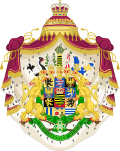 | |
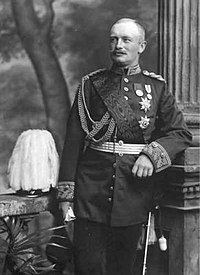 Frederick Augustus III | |
| Details | |
| Style | His Majesty |
| First monarch | Hadugato |
| Last monarch | Frederick Augustus III |
| Formation | 531 |
| Abolition | 13 November 1918 |
| Appointer | Hereditary |
| Pretender(s) | Disputed: Daniel, Margrave of Meissen or Prince Alexander |
This article lists dukes, electors, and kings ruling over different territories named Saxony from the beginning of the Saxon Duchy in the 6th century to the end of the German monarchies in 1918.
The electors of Saxony from John the Steadfast onwards were Lutheran until Augustus II of Saxony converted to Catholicism in order to be elected King of Poland and Grand Duke of Lithuania. His descendants (including all Kings of Saxony) have since been Catholic.
Old Saxony

The original Duchy of Saxony comprised the lands of the Saxons in the north-western part of present-day Germany, namely, the contemporary German state of Lower Saxony as well as Westphalia and Western Saxony-Anhalt, not corresponding to the modern German state of Saxony.
Frankish king Charlemagne conquered Saxony and integrated it into the Carolingian Empire. In the later 9th century, power began to shift from the (Eastern) Frankish king to the local Saxon rulers, resulting in the emergence of the Younger stem duchy.
Independent Saxony
- Hadugato (fl. c. 531)
- Berthoald (fl. c. 622)
- Theoderic (fl. c. 743–744)
- Widukind (c. 777–785), leader against Charlemagne
- Albion (fl. c. 785–811)
Saxony as part of Frankish kingdom(s)
| Dukes of Saxony | |||
|---|---|---|---|
| Image | Name | Reign | Notes |
| Hattonid Dynasty | |||
| Banzleib | 838 – 840 | Comes et marchio | |
| Liudolfing/Ottonian Dynasty | |||

|
Liudolf I | 850 – 12 March 864 or 866 | Comes et marchio |

|
Bruno | 12 March 864 or 866 – 2 February 880 | Comes et marchio |

|
Otto I the Illustrious | 2 February 880 – 30 November 912 | first Duke of the Younger stem duchy |

|
Henry I the Fowler | 30 November 912 – 2 July 936 | Also German King 919–936 |

|
Otto II the Great | 2 July 936 – 961 | Also German King 936–973, Emperor 962–973 |
| Billung Dynasty | |||

|
Hermann | 961 – 27 March 973 | |
| Bernard I | 27 March 973 – 9 February 1011 | ||

|
Bernard II | 9 February 1011 – 29 June 1059 | |

|
Ordulf | 29 June 1059 – 28 March 1072 | |

|
Magnus | 28 March 1072 – 23 August 1106 | |
| Supplinburg Dynasty | |||

|
Lothar | 1106 – 4 December 1137 | Also German King 1125–1137, Emperor 1133–1137 |
| Ascanian Dynasty | |||
| Otto the Rich | 1112 | Appointed by Emperor Henry V in opposition to Duke Lothar. Otto was the son-in-law of Duke Magnus Billung and the father of later Duke, Albert the Bear. | |
| House of Mansfeld | |||
| Hoyer I, Count of Mansfeld | 1115 | Appointed by Emperor Henry V in opposition to Duke Lothar. | |
| Welf Dynasty | |||

|
Henry the Proud | 4 December 1137 – 20 October 1139 | son-in-law of Lothar; also Duke of Bavaria |
| Ascanian Dynasty | |||

|
Albert the Bear | 20 October 1139 – 1142 | son of Otto the Rich and grandson of Magnus Billung; also Margrave of Brandenburg |
| Welf Dynasty | |||

|
Henry the Lion | 1142–1180 | son of Henry the Proud and grandson of Lothair III; also Duke of Bavaria |
With the removal of the Welfs in 1180, the Duchy of Saxony was sharply reduced in territory. Westphalia fell to the Archbishop of Cologne, while the Duchy of Brunswick remained with the Welfs. The Ascanian Dukes had their base further east, near the Elbe, in what is sometimes called the younger Duchy of Saxony, resulting in the name Saxony moving towards the east. After the division, the counting of the dukes started anew. Though the first Ascanian duke is competingly counted as Bernard III (because of two predecessors of the same name before 1180) or as Bernard I, his successor, Albert I is already usually counted as the first, although before 1180 he had one predecessor of the same name, Albert the Bear.
In the 10th century the Emperor Otto I had created the County Palatine of Saxony in the Saale-Unstrut area of southern Saxony. The honour was initially held by a Count of Hessengau, then from the early 11th century by the Counts of Goseck, later by the Counts of Sommerschenburg, and still later by the Landgraves of Thuringia. When the Wettin landgraves succeeded to the Electorate of Saxony, the two positions merged.
The Younger Saxony: The Duchy and the Electorate
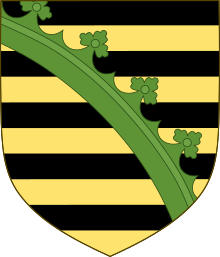
The new dukes replaced the Saxon horse emblem (![]() ) and introduced their Ascanian family colours and emblem (
) and introduced their Ascanian family colours and emblem (![]() ) added by a bendwise crancelin, symbolising the Saxon ducal crown, as new coat-of-arms of Saxony (
) added by a bendwise crancelin, symbolising the Saxon ducal crown, as new coat-of-arms of Saxony (![]() ). The later rulers of the House of Wettin adopted the Ascanian coat-of-arms.
). The later rulers of the House of Wettin adopted the Ascanian coat-of-arms.
After the division, the counting of the dukes started anew. Though the first Ascanian duke is counted either as Bernard III (because of two predecessors of the same name before 1180) or as Bernard I, his successor, Albert I is counted as the first, although before 1180 he had one predecessor of the same name, Albert the Bear.
House of Ascania
Partitions of Saxony under Ascanian rule
| Duchy of Saxony (1180–1296) | ||||
| Duchy of Saxe-Wittenberg (1296–1356) Raised to: Electorate of Saxe-Wittenberg (1356–1422) |
Duchy of Saxe-Lauenburg (1296–1303) | |||
| Duchy of Saxe-Ratzeburg (1303–1315) | ||||
| Duchy of Saxe-Mölln (1303–1401) |
Duchy of Saxe-Bergdorf (1303–1315) Renamed as Duchy of Saxe-Ratzeburg (1315-1401) | |||
| Duchy of Saxe-Lauenburg (Ratzeburg line) (1401–1689) | ||||
Table of rulers
(Note: Both lines follow the numbering established in this table until 1296, when they were created. From 1296 on, each line follows independently the succession of Saxon dukes until 1296)
| Ruler | Born | Reign | Death | Ruling part | Consort | Notes | |
|---|---|---|---|---|---|---|---|
| Bernard III |  |
c.1134 | 1180–1212 | 2 February 1212 | Saxony | Brigitte of Denmark six children Sophia of Thuringia one child Judith of Poland c.1173 no children |
Also Count of Ballenstedt and Prince of Anhalt. Numberings starting with Ascanian rule or continuing after prior dukes of the same name. Father of the following. |
| Albert I | 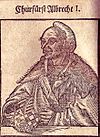 |
c.1175 | 1212–1260 | 7 October 1260 | Saxony | Agnes of Austria 1222 five children Agnes of Thuringia 1238 three children Helene of Brunswick-Lüneburg 1247 five children |
Father of the following two dukes |
| Albert II | 
|
1250 | 1260–1296 | 25 August 1298 | Saxony | Agnes of Austria 1282 six children |
Ruled jointly; and associated his nephews to the joint rulership after his brothers death. However, these three nephews divided the land with him. Albert II retained Saxe-Wittenberg, and became the head of the Elder Saxon Line; Albert III, Eric I and John II ruled together in Saxe-Lauenburg, becoming the founders of the Younger Saxon Line. |
| 1296–1298 | Saxe-Wittenberg | ||||||
| John I | 1249 | 1260–1282 | 30 July 1285 | Saxony | Ingeborg Birgersdotter of Sweden 1270 eight children | ||
| In 1296 Albert II and his nephews Albert III, Eric I, and John II ended their joint rule and divided Saxony into the Lauenburg line, where Albert III, Eric I, and John II continued to rule jointly until 1303, and the Wittenberg line, where Albert II continued as sole ruler until 1298. Since the Duke of Saxony was considered one of the prince-electors electing a new Holy Roman Emperor, conflict arose between the lines of Lauenburg and Wittenberg over the issue of who should cast Saxony's vote. In 1314 both lines found themselves on different sides in a double election. Eventually, the Dukes of Saxe-Wittenberg succeeded in 1356 after the promulgation of the Golden Bull. To distinguish him from other rulers bearing the title Duke of Saxony, he was commonly called Elector of Saxony. | |||||||
| John II | 1275 | 1296–1303 | 22 April 1322 | Saxe-Lauenburg | Elizabeth of Holstein-Rendsburg 1315 one child |
Children of John I, co-ruled first with their uncle Albert II since 1282 (since the death of their father), and in 1296 split the land with him. They retained Lauenburg, which they divided once more. Albert passed the land to his widow, and after her death, in 1315, the territory was realigned: Eric divided Bergdorf with his surviving brother and held all of his brother Albert's inheritance. However, he ended up abdicating to his son, and survived for most of his reign. | |
| 1303–1322 | Saxe-Mölln | ||||||
| Eric I | 
|
1280 | 1296–1303 | 1360 | Saxe-Lauenburg | Elisabeth of Pomerania 1316 or 1318 four children | |
| 1303–1338 | Saxe-Bergedorf (1303-15) Saxe-Ratzeburg (1315-38) | ||||||
| Albert III | 1281 | 1296-1303 | 1308 | Saxe-Lauenburg | Margaret of Brandenburg-Salzwedel 1302 two children | ||
| 1303–1308 | Saxe-Ratzeburg | ||||||
| Margaret of Brandenburg-Salzwedel | 1270 | 1308–1315 | 1 May 1315 | Saxe-Ratzeburg | Przemysł II, King of Poland 1302 two children Albert III 1302 two children | ||
| In 1315, after the death of Margaret of Brandenburg, the remaining brothers Eric and John redesigned the political division in Saxe-Lauenburg; Eric retained all of Margaret's part, but had to give part of his original domains to his brother. | |||||||
| Rudolph I (Rudolf I) |
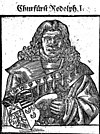 |
1284 | 1298-1356 10 January 1356 – 12 March 1356 |
12 March 1356 | Saxe-Wittenberg Electorate of Saxony |
Jutta of Brandenburg 1298 eight children Kunigunde of Poland 28 August 1328 one child Agnes of Lindow-Ruppin 1333 three children |
In January 1356 the Golden Bull confirmed Rudolf I as the legitimate Saxon Prince-Elector, thus the rulers of Saxe-Wittenberg are conceived as Electors of Saxony. |
| The Golden Bull of 1356 confirmed the right to participate in the election of a Holy Roman Emperor to the Duke of Saxony in the Saxe-Wittenberg line. | |||||||
| Regency of Elizabeth of Holstein-Rendsburg (1322-1330) | |||||||
| Albert IV | 1315 | 1322–1343 | 1343 | Saxe-Mölln | Beata of Schwerin 1334 three child Sophia of Mecklenburg-Werle-Güstrow 1341 no children | ||
| Eric II | 1318/20 | 1338–1368 | 1368 | Saxe-Ratzeburg | Agnes of Holstein-Plön between 1342 and 1349 four children |
||
| John III | c.1330 | 1343–1356 | 1356 | Saxe-Mölln | Unmarried | Left no descendants. He was succeeded by his brother, Albert. | |
| Albert V | c.1330 | 1356–1370 | 1370 | Saxe-Mölln | Catherine of Mecklenburg-Werle-Güstrow 25 January 1366 no children |
Left no descendants. He was succeeded by his brother, Eric. | |
| Rudolph II the Blind (Rudolf II. der Blinde) |
 |
1307 | 12 March 1356 – 6 December 1370 | 6 December 1370 | Saxe-Wittenberg and Electorate of Saxony | Elisabeth of Hesse Before 8 May 1336 one child |
Left no descendants. |
| Wenceslaus I |  |
1337 | 6 December 1370 – 15 May 1388 | 15 May 1388 | Saxe-Wittenberg and Electorate of Saxony | Cecilia da Carrara 23 January 1376 six children |
Brother of his predecessor. |
| Eric III | 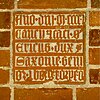 |
c.1330 | 1370–1401 | 1401 | Saxe-Mölln | Unmarried | Determined to enter to clergy, has to resign to succeed his brothers. He also left no descendants, which allowed the Saxe-Ratzeburg-Lauenburg line to reunite Saxe-Lauenburg. |
| Rudolph III | 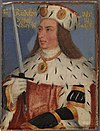 |
1378 | 15 May 1388 – 11 June 1419 | 11 June 1419 | Saxe-Wittenberg and Electorate of Saxony | Anna of Meissen 1387/89 three children Barbara of Legnica March 1396 two children |
Left no male descendants. he was succeeded by his brother, Albert. |
| In 1401 Saxe-Ratzeburg-Lauenburg inherited Saxe-Bergedorf-Mölln from the Ascanian Elder Lauenburg line there extinct upon Eric IV's death. The reunited duchy continued under the old name of Saxe-Lauenburg. | |||||||
| Eric IV | 1354 | 1368–1401 | 21 June 1411/12 | Saxe-Ratzeburg | Sophia of Brunswick-Lüneburg 8 April 1373 ten children |
In 1401 reunited Saxe-Lauenburg. | |
| 1401–1411/12 | Saxe-Lauenburg | ||||||
| Eric V | after 1373 | 1411/12–1436 | 1436 | Saxe-Lauenburg | Elisabeth of Holstein-Rendsburg 1404 no children Elisabeth of Weinsberg before 1422 one child |
Ruled jointly. The numberings here lead to some confusion, as not all genealogists of the House of Ascania count John IV in the list of Dukes of Saxe-Lauenburg, numbering John V (John IV's nephew) as John IV. | |
| John IV | after 1373 | 1411/12–1414 | 1414 | Saxe-Lauenburg | Unmarried | ||
| Albert IV |  |
1375/80 | 11 June 1419 – (before 12 November) 1422 | before 12 November 1422 | Saxe-Wittenberg and Electorate of Saxony | Euphemia of Oleśnica 14 January 1420 no children |
Left no male descendants, which led the Ascanian Saxe-Wittenberg line to extinction. |
| The Ascanian Dynasty continued in Saxe-Lauenburg until 1689, but after the Lauenburgish line had finally lost the Saxon Electorate to the Wittenberg line in 1356 and failed to obtain the succession in the Electorate after 1422, recognition of the Dukes of Saxe-Lauenburg as Dukes of Saxony waned. To follow the remnant House of Ascania in Saxe-Lauenburg, follow this table. For the following Electors of Saxony, see below the House of Wettin. | |||||||
| Bernard IV | 1385/93 | 1436–1463 | 16 July 1463 | Saxe-Lauenburg | Adelaide of Pomerania-Stolp 1428 two children |
||
| John V | 18 July 1439 | 1463–1507 | 15 August 1507 | Saxe-Lauenburg | Dorothea of Brandenburg 12 February 1464 twelve children |
Sometimes numbered John IV. He is sometimes confused with his uncle, John IV (Eric V and Bernard IV's brother) and a son of his own (John IV, Bishop of Hildesheim). | |
| Magnus I |  |
1 January 1470 | 1507–1543 | 1 August 1543 | Saxe-Lauenburg | Catherine of Brunswick-Wolfenbüttel 20 November 1509 Wolfenbüttel six children |
|
| Francis I | 1510 | 1543-1571 | 19 March 1581 | Saxe-Lauenburg | Sibylle of Saxony 8 February 1540 Dresden nine children |
In 1571 – highly indebted – Francis I resigned in favour of his eldest son Magnus II, who had promised to redeem the pawned ducal demesnes with funds he gained as Swedish military commander and by his marriage to a Swedish princess. | |
| Magnus II | 1543 | 1571–1573 | 14 March 1603 | Saxe-Lauenburg | Sophia of Sweden 4 July 1568 Stockholm one child |
Eldest son of Francis I. He didn't pay the debts he promised to pay and led to war with his father and brothers. Two years later they deposed Magnus II and Francis I re-ascended. Magnus' violent and judicial attempts to regain the duchy failed. In 1588 he was imprisoned for the remainder of his life. | |
| Francis I | 1510 | 1573–1581 | 19 March 1581 | Saxe-Lauenburg | Sibylle of Saxony 8 February 1540 Dresden nine children |
Regained the title in 1573, after pushing back Magnus II. | |
| Francis II | 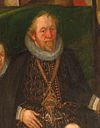 |
10 August 1547 | 1581–1619 | 2 July 1619 | Saxe-Lauenburg | Margaret of Pomerania-Wolgast 26 December 1574 Wolgast four children Maria of Brunswick-Wolfenbüttel 10 November 1582 Wolfenbüttel fourteen children |
Brother of Magnus II. Vice-regent from 1578, administrator from 1581. Joint rule with his brother Maurice between 1581 and 1612. Father of Augustus and Julius Henry. |
| Maurice | 1551 | 1581–1612 | 2 November 1612 | Saxe-Lauenburg | Katharina von Spörck 1581 (annulled 1582) no children |
Ruled jointly with his brother Francis II. | |
| Augustus | 17 February 1577 | 1619–1656 | 18 January 1656 | Saxe-Lauenburg | Elisabeth Sofie of Holstein-Gottorp 5 March 1621 Husum six children Catherine of Oldenburg 4 June 1633 no children |
Left no male descendants; he was succeeded by his half-brother Julius Henry. | |
| Julius Henry |  |
9 April 1586 | 1656–1665 | 20 November 1665 | Saxe-Lauenburg | Anna of East Frisia 17 March 1617 Grabow no children Elisabeth Sophia of Brandenburg 4 June 1633 Toužim one son Anna Magdalena of Lobkowicz 18 August 1632 Vienna six children |
|
| Francis Erdmann | 25 February 1629 | 1665–1666 | 30 July 1666 | Saxe-Lauenburg | Sibylle Hedwig of Saxe-Lauenburg 1654 no children |
Left no descendants; He was succeeded by his brother Julius Francis. | |
| Julius Francis |  |
16 September 1641 | 1666–1689 | 30 September 1689 | Saxe-Lauenburg | Hedwig of the Palatinate-Sulzbach 9 April 1668 Sulzbach two children |
|
The male line of the Saxe-Lauenburgish Ascanians was extinguished in 1689, after Julius Francis' death. In spite of having left two daughters to inherit the rights to the duchy, the House of Welf usurped the duchy, preventing the succession of the legitimate heiress, Anna Maria Franziska of Saxe-Lauenburg, and resucceeded with its Brunswick and Lunenburg-Celle line. In fact, George William, Duke of Brunswick-Lüneburg was a great-great-grandson of Magnus I through his great-grandmother Dorothea of Saxe-Lauenburg. His descendants became Monarchs of Great Britain from 1714 on. In 1814, after being deposed by various occupations in the Napoleonic Wars, George III's son, Regent George agreed to pass Saxe-Lauenburg to his Danish cousin in a general territorial realignment at the Congress of Vienna. This cousin was Frederick VI of Denmark, who changed the official colours of Saxe-Lauenburg to red and gold. The duchy changed hands again when, in 1865, Christian IX of Denmark was deposed in Second Schleswig War and resigned by Treaty of Vienna; Saxe-Lauenburg passed to William I of Prussia, to whom the Estates of Saxe-Lauenburg offered the ducal throne. The coat-of-arms of Saxe-Lauenburg was changed to the colours red and silver, with a border in the Prussian colours of black and white. Both duke and estates decided to merge Saxe-Lauenburg into Prussia, as district Duchy of Lauenburg, with effect from 1 July 1876.
House of Wettin
The Ascanian line of Saxe-Wittenberg became extinct with the death of Elector Albert III in 1422, whereafter Emperor Sigismund bestowed the country and electoral dignity upon Margrave Frederick IV of Meissen, who had been a loyal supporter in the Hussite Wars. Late Albert's Ascanian relative Duke Eric V of Saxe-Lauenburg protested in vain. Frederick, now one of the seven Prince-electors, was a member of the House of Wettin, which since 1089 had ruled over the adjacent Margraviate of Meissen up the Elbe river, established under Emperor Otto I in 965, and since 1242 also over the Landgraviate of Thuringia. Thus, in 1423, Saxe-Wittenberg, the Margraviate of Meissen and Thuringia were united under one ruler, and the unified territory. gradually received the name of (Upper) Saxony (or simply Saxony).
Partitions of Saxony under Wettin rule
| Electorate of Saxony (1422–1464) | |||||||||||||||||||||||||||
| Albertine territories | Ernestine territories | ||||||||||||||||||||||||||
| Albertine Duchy of Saxony (1464–1547) |
Ernestine Electorate of Saxony (1464–1547) | ||||||||||||||||||||||||||
| Coburg (1542–53) |
|||||||||||||||||||||||||||
| Albertine Electorate of Saxony (1547–1806) |
Ernestine Duchy of Saxony (1547–1554) | ||||||||||||||||||||||||||
| Coburg & Eisenach (1554–66) |
Gotha (1554–65) |
Weimar (1554–66) | |||||||||||||||||||||||||
